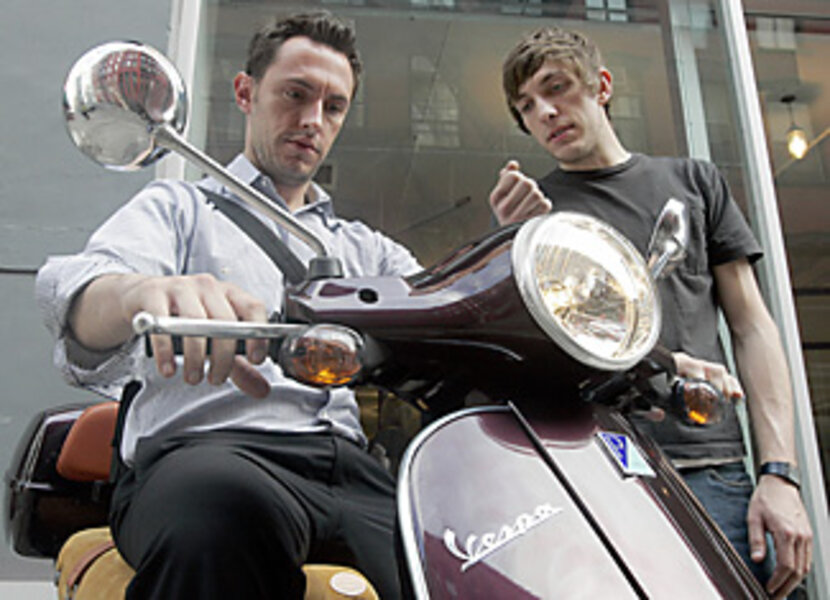Easy riders: Scooters on road toward mainstream acceptance
Loading...
Long a familiar sight on the roads of Europe and Asia, motorized scooters are still relatively rare in the United States. While much of the world views them as a practical – and often stylish – necessity, they've occupied more of a niche market in the car-centric US, where scooter riders were perhaps justifiably seen as more concerned with fashion than with function.
But the scooter's image is evolving, and scooter numbers are rising: Scooter sales in the US have jumped dramatically in recent years, from roughly 20,000 units sold in 1999 to over 150,000 in 2006.
"People are migrating toward scooters for all the right reasons," says Kevin Andrews, Piaggio/Vespa brand manager for Piaggio USA, which showed off several lines of classic and modern scooters at a motorcycle show in New York City in December. "They average about 70 miles per gallon; every time the price of gas goes up, people give us more consideration, which is great."
While the rising price of gasoline is generally seen as the main cause of that jump – depending on engine size, scooters can get 50 to 100 miles per gallon – the boom is also being fueled by frustrations with traffic jams, an aging population that is trading down from heavier two-wheelers, and what one longtime industry observer terms the "culturization" of scooters .
"People were seeing them more on the TV and the news, and it just got to the point where people were seeing them enough to say, 'That would be a cool thing to do,' " says Robert Slover, district sales manager for Kymco, which builds scooters as well as full-size motorcycles at factories in Taiwan and mainland China, selling them both under the Kymco brand name, as well as that of Honda.
Mr. Slover explains that as sales have risen (which began, coincidentally, right around the time when he started working for the company) the public has also noticed that scooters are no longer just small, fragile, poorly made toys. For example, thanks largely to tighter emission controls, the noisy two-stroke engines of old are on their way out, replaced by fuel-injected four strokes. Also going out of use, says Slover, are the low-grade body plastics that tended to shatter if the scooter ended up on its side.
"All the technology that has been developed for the last 40 years from all the motorcycle manufacturers, be it European, Japanese, or whatever, has now flowed into the motor-scooter market," says Slover. "You've got disc brakes with steel-braided brake lines, you've got automatic transmissions with liquid coolant in engines. All that technology makes them easier to operate, and they last longer."
And many of them also go quite a bit faster. While the typical scooter of yesteryear was neither powerful enough nor stable enough to take out on the highway, many companies offer models that are capable of topping 100 miles per hour. Such scooters have been common in Europe for some time but have only recently gained a foothold here as people buy scooters not just for recreation, but for utility, keeping up with cars at highway speeds being one such function.
"In Europe, people think of motorcycles as a means. Here, they think of them as entertainment," says Tom Parr, a regional service representative for Yamaha. "You buy motorcycles in the US to be seen riding; 10 percent of [buyers] ride them for the sake of riding them. But in Europe, it's the other way around."
But even for those whose main reason for buying a scooter is function, there are many forms to choose from. Yamaha's sleek, low-slung Morphous – reminiscent of something Batman might ride to the corner store – stopped many New York showgoers in their tracks, as it presumably does on the highway, while fans of the Vespa brand can choose from several different "retro" models styled after favorites from the '50s, '60s, and '70s.
Along with a range of styles, seemingly all scooter manufacturers offer a wide range of models, ranging from tiny, 50-cc in-town models on up to 500-cc tourers. That latter group, of course, raises the question of what, exactly, is the dividing line between a scooter and a motorcycle. While the performance gap has narrowed between high-end scooters and motorcycles, Kymco's Slover points out that there are still some fundamental differences between a scooter and a motorcycle. While all scooters have automatic transmissions – still a relatively rare sight on motorcycles – the main distinction is in the body configuration: If you can step through it rather than straddle it, it's a scooter. The body style, Slover continues, also makes scooters somewhat safer, as both the engine and the gas tank sit lower on the body and provide a lower center of gravity.
But Slover, who has both scooters and full-size rides among the 15 new and vintage motorbikes he keeps in his garage, says the difference is one of attitude. Motorcyclists are out there to ride, he says with a mock-intense expression; scooter people are out there to smile.
"It really boils down to smile factor. They're fun to ride. That's the biggest thing – they're easy, they're fun. I kid around and say, 'If you can keep your butt on a seat, and your balance on two wheels, and twist your hands and work your fingers, you can ride a motor scooter.' "






